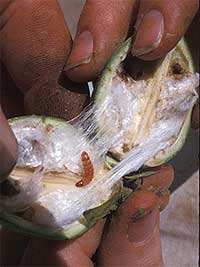Tucson, Arizona
October 19, 2005
By Mari N. Jensen
 |
|
A cotton boll with a pink
boll caterpillar inside. Photo credit: Timothy Dennehy. |
Biotech cotton
has beaten back pink bollworm eight years running, reports a
team of scientists from The
University of Arizona (UA) in Tucson.
The surprising finding is good news for the environment. Arizona
farmers who plant the biotech cotton known as Bt cotton use
substantially less chemical insecticides than in the past.
Insect pests sometimes evolve resistance to such chemicals in
just a few years, a fate that was predicted for biotech crops
genetically altered to produce Bt toxin, a naturally occurring
insecticide.
"This is the most complete study to date for monitoring
resistance to Bt crops," said team leader Bruce E. Tabashnik,
the head of UA's department of entomology, a member of UA's BIO5
Institute and an expert in insect resistance to insecticides.
“We found no net increase in insect resistance to Bt. If
anything, resistance decreased. This is the opposite of what
experts predicted when these crops were first commercialized.”
He added, “I’m definitely surprised.”
Tabashnik, Timothy J. Dennehy, a UA Distinguished University
Outreach Professor of Entomology and extension specialist and a
member of BIO5, and Yves Carriere, UA associate professor of
entomology, will publish their research in an upcoming issue of
the Proceedings of the National Academy of Sciences.
Bt cotton has been planted in Arizona since 1996. Now more than
half of the state’s 256,000 acres of cotton fields are planted
with the biotech plants. Without the protection provided by Bt
cotton, some fields can have 100 percent of plants infested with
pink bollworm caterpillars, which live inside the cotton boll,
destroying the crop.
Dennehy said, “In an extreme infestation, you can have every
single boll in the field infected." The caterpillars eat the
seeds and damage the developing cotton fibers.
In contrast, when the caterpillars eat Bt cotton, they die.
 |
|
Cotton fields in Parker
Valley, Ariz. Bt cotton is the greener field in the
foreground. The whiter swath of cotton in the background
is a refuge field of non-Bt cotton. Photo credit:
Timothy Dennehy. |
Before the use
of Bt cotton became widespread, pink bollworm was one of the top
three insect pests of cotton in the Southwest. In 1995, losses
from pink bollworm in Arizona cotton were estimated to be $8.48
per acre, totaling $3.4 million statewide. Cotton is grown in
eight Arizona counties: Cochise, Graham, La Paz, Maricopa,
Mohave, Pima, Pinal and Yuma.
"Moreover, the harsh insecticides used to control pink bollworm
resulted in a host of other insect pests becoming more serious
problems," Dennehy said.
Everything changed in 1996, he said, when Bt cotton and two
other "soft" insect control tactics replaced a large amount of
the harsh pesticides used on cotton crops. Spraying less
chemical insecticides means more beneficial insects survive,
further reducing the need for spraying.
By 2004, pink bollworm losses had fallen to nearly half of
earlier levels, $4.34 per acre.
Tabashnik said, “Some of the other pests are not so much of a
problem because we’re not killing their natural enemies with
insecticides."
Dennehy added, “These soft toxins plus the good bugs acting
together have driven pesticide use to historic low levels ...
this is a wonderful success of integrated pest management.”
Since widespread adoption of Bt cotton in 1997, insecticide use
on Arizona’s cotton crops is down 60 percent, said Tabashnik.
The reduction in chemical pesticide use saves growers about $80
per acre. According to the Arizona Agricultural Statistics
Bulletin, the value of Arizona's cotton crops for 2004 was
estimated at $207 million.
The key to Bt cotton’s continued efficacy is the use of refuges
– patches of traditional cotton intermingled with the fields of
Bt cotton.
The refuges ensure that the few pink bollworm moths that are
resistant to Bt are most likely to mate with Bt-susceptible pink
bollworm moths that grew up in the refuges. The offspring from
such matings die when they eat Bt cotton.
In contrast, if all of Arizona’s cotton was Bt cotton, only pink
bollworm caterpillars that were resistant to the Bt toxin would
survive. If resistant pink bollworm moths mated with each other,
their offspring would be resistant and could feed on Bt cotton.
Bt cotton would then become useless against pink bollworm.
The UA team used a combination of field surveys, laboratory
testing and mathematical modeling to determine if pink bollworm
had become resistant to Bt cotton.
The team did find Bt-resistant pink bollworm caterpillars in the
field, but they were rare.
Tabashnik said that doesn’t mean the insects won’t bite back in
the future. "It's not that pink bollworm can't beat Bt toxin,
but that it hasn't beaten Bt toxin so far."
There's a new variety Bt cotton now available that has two
different Bt toxins, he said. The team's next step will be to
determine how to best use that combination of toxins to stay one
step ahead of the pink bollworms.
The U.S. Department of Agriculture, the Arizona Cotton Research
and Protection Council, the Monsanto Company, and Cotton, Inc.
funded the research. |